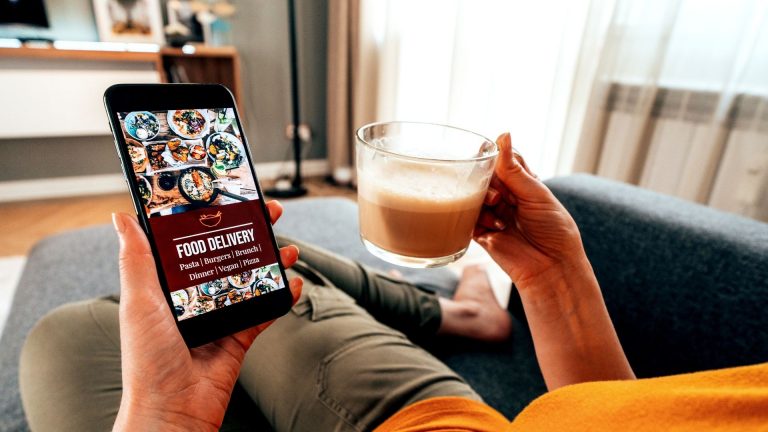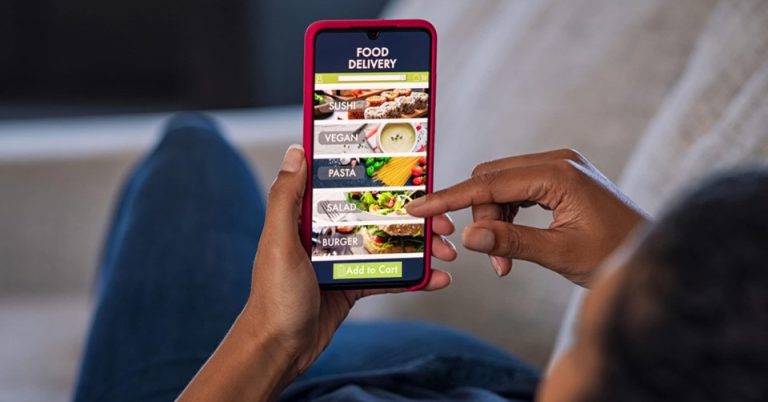Malaysians fondly refer to themselves as foodies and what foodies crave the most is the vast and varied cuisines Malaysia has to offer. However, there are days where people are constrained by time and place and unable to go out and obtain the food they crave with their own hands, especially during the restricted movement periods that we have gone through since the beginning of COVID-19 pandemic. This is where food delivery apps in Malaysia have flourished like never before, sending a fleet of delivery men flying to citizens all over the country to save the day – like Santa Claus in a helmet carrying an insulated bag full of goodies. The food delivery ecosystem has been expanding without a doubt, but how has the landscape changed since the beginning of the pandemic?
How Food Delivery Apps Work
Food delivery services have been around for ages but prior to the revolution of smartphones and digital delivery apps, the ways in which customers could order food delivery from restaurants was limited mostly to phone calls or placing advance orders with the restaurants in person. The advent of food delivery apps revolutionized food delivery by adding a convenience for both customers and restaurants that hadn’t existed before. Rather than having to look up contact numbers and discover restaurants by chance or word of mouth, customers now have a vast array of choices at their fingertips, all of which can be ordered from with just a few clicks. Restaurants also benefit as the delivery apps provide visibility to customers who may not have known about the restaurant otherwise, and act as an automated platform which allows restaurants to take orders and handle payment from customers.
The landscape of food delivery apps was further boosted during the movement control order (MCO) period as more restaurants jumped on board the network as one of their only remaining means of survival when dining-in was prohibited.Food delivery apps have also been improving their services by offering more options to their consumers such as delivery times and delivery methods like ‘contactless delivery’ that help to cut down the need to stand and wait at the door. Some food delivery services even offer specialized selections for specific dietary needs. Even the many people who own a pet can also benefit from PledgeCare that offers natural and healthy pet food deliveries.
Why Are Food Deliveries Popular?
The trend of food delivery apps in Malaysia becoming more and more popular is expected to continue, especially with its captivating promotions and loyalty schemes. Besides sales driven by industry advertisements, one of the root causes of this booming trend is attributed to consumer behavior. Consumers nowadays are attracted to the modernized food delivery platforms that allow them to customize their ordering experience. You can specify different addresses, delivery times, and include instructions to both restaurants and delivery drivers. The various payment options such as payment via debit or credit card, cash upon delivery, or through third party e-wallets, also cater to the needs and wants of consumers.
Moreover, delivery speed plays a large factor as well since the average consumer will wait no more than 60 minutes for their order. Delivery speed is quoted as one of the contributors to customer satisfaction. And naturally, location is also a major driving force as orders are often placed from home as some people don’t want to cook or simply wish to avoid the traffic outside.
Types of Food Delivery Apps in Malaysia
Food delivery apps in Malaysia were an up and coming trend, and the pandemic has certainly given the industry an enormous boost – given that people were forced to stay at home during the various stages of MCO. Moreover, restaurants were also forced to adapt to this trend in order to survive.
There are two broad categories of food delivery apps in Malaysia. The first is third party delivery apps. These are platforms which are open for almost any restaurant to register for and utilize provided they meet the requirements set out by the platform. This category includes the most used food delivery apps such as FoodPanda, Grab, and other up and coming apps such as Pop Meals and AirAsia Food. The other category would be merchant delivery apps. These are apps which are used exclusively for a particular restaurant/franchise such as McDonalds, KFC, Domino’s Pizza, and so on.
63% of Malaysians have ordered food from food delivery apps in the Past 3 Months (P3M), with 3rd party delivery apps being more widely used at 49% compared to merchant’s delivery apps at 38%. This could be due to the larger selection of restaurants or food as compared to merchant’s delivery apps which have a limited menu.
Who are the Delivery App Users?
In terms of the general population, delivery app users are slightly younger at an average of 35 years old and largely skewed towards Malay at a high 62% in comparison to Chinese (29%) and Indian (9%). Most users are also non-PMEB (54%), singles and with higher household income. A majority of users are also living in the KL/PJ area (58%) which could be attributed to the fact that many people want to avoid traffic jams just to get a meal out.
Looking into the users of 3rd party delivery app versus merchant’s delivery app, users of 3rd party delivery app are younger with an average age of 33.9 years old. On the other hand, users of merchant’s delivery app are seen to be more mature at 36.3 years old and skewed towards married individuals in addition to having a much higher household income.
Which Delivery Apps Are Used?
So which delivery apps do Malaysian often use? FoodPanda is leading the 3rd party delivery app category with 91% usage in the P3M. GrabFood comes in at second place with 78% of Malaysian using the app in the P3M. These two are the major players in the scene while other apps such as BungkusIt, Delivery Eat, AirAsia Food, etc pale in comparison.
Merchant Delivery Apps Used
When it comes to merchant’s delivery apps, it is no surprise to see McDonald’s (73%), KFC (50%) and Pizza Hut (38%) occupying the top 3 spots since they are the largest Quick Service Restaurants (QSRs) in Malaysia – with McDonald’s being the most used merchant’s delivery app around 20% ahead of KFC.
The Top 10 Types of Food Ordered
Now, let’s take a look at what type of food Malaysians usually order via food delivery apps. Fast food is the top favorite food among Malaysians at 78% followed closely by Malay food at 53% which comes as no surprise considering a majority of food delivery app users are Malay.
On top of that, the penetration rate of Western food, beverages, and Chinese food are very similar ranging from 23% – 29%. These make the top 5 types of food favored by Malaysians. Thai food is also a noteworthy category as it ties with Chinese food at 23%.
How Often do Malaysians Order?
Taking a look at the frequency of usage, on average Malaysians make orders via delivery apps 1-2 times a week. Most users order 2-3 times a month at 42%, followed by once a week (26%), and 2-3 times a week (22%).
Diving specifically into the top 5 types of cuisine ordered, the statistics show that Chinese & Western food are being ordered most often with both close to 2 times a week. However Malay food and beverages are not far off behind at about 1.5 times a week.
Although fast food is the top favorite type of food among Malaysians, its order frequency is the lowest among the top 5 food types. This could be due to health concerns since fast food is generally associated with being “unhealthy” and most Malaysians are health conscious.
How Often do Different Malaysian Segments Order?
In terms of the age groups, Generation Y seems to have a higher order frequency at 1.4 times a week. Meanwhile Generation Z and Generation X order less often each week respectively.
As for the income group, the T20 groups (RM10,000 & above) are ordering food delivery two to three times a week on average than the other income groups that only order around once a week. Work position wise, PMEBs (1.8 times) tend to order more frequently compared to non-PMEB (1.2 times) occupations.
When Do Malaysians Usually Order?
In general, Malaysians usually order food in the afternoon and evening dayparts considering those as lunch and dinner times. This is especially so for beverages (63%) and Chinese food (61%).
In addition to that, Malaysians also have a higher tendency to order Malay food (22%), Western food (22%) and beverages (21%) in the late morning.
The Average Amount Spent Per Order
Excluding delivery charges, Malaysians typically spend around RM45.60 per order. Western and Chinese food recorded the highest average spend per order at RM48.75 and RM46.62 respectively.
In contrast, at RM43.55, beverages have the lowest average spend per order and are slightly below the total average.
How About By Demographic Groups?
Which demographic groups actually spend more on food deliveries? Generation X tops the chart at RM52.41 followed by Generation Y at RM46.75. This is probably due to the higher earning power and different life stages with these older generations being busy with work. As seen above, average spend increases as MHI grows.
Based on the statistics married individuals are seen to be spending more since they will probably need to make orders for the entire household as well. In terms of work position, it is the PMEBs (RM53.40) who are spending more on food deliveries.
Consumers are inclined towards time saving, convenience, and customizable factors. Due to increasingly busy lifestyles and time constraints, people don’t have the leisure to wait for their food at restaurants and prefer to have the food delivered to them.
And with the pandemic still ongoing, ordering from the safety of their homes is also more appealing. Food delivery trends will expand as innovative technology such as delivery drones and autonomous food delivery are starting to pick up in other countries. As such the food and beverages industry should learn to adapt to food delivery trends. Restaurants and eateries must consider key points such as search engine optimization as more people will search for what they want to eat online than going around to physical locations.
If you would like to dive deeper into the data behind food delivery apps in Malaysia, feel free to contact us at theteam@oppotus.com

